Some years ago I came across a really peculiar newsgroup post. It was not about technicalities of any sort. It was about history. A beautifully written history of computers. From the Turing machine to the Free Software world, the original author managed to capture all the important events of the computer revolution with a great deal of humor. Re-posting it here, it is just brilliant.
The Gospel of Tux (v1.0)
In the beginning Turing created the Machine.
And the Machine was crufty and bodacious, existing in theory only. And von Neumann looked upon the Machine, and saw that it was crufty. He divided the Machine into two Abstractions, the Data and the Code, and yet the two were one Architecture. This is a great Mystery, and the beginning of wisdom.
And von Neumann spoke unto the Architecture, and blessed it, saying, Go forth and replicate, freely exchanging data and code, and bring forth all manner of devices unto the earth. And it was so, and it was cool. The Architecture prospered and was implemented in hardware and software. And it brought forth many Systems unto the earth.
The first Systems were mighty giants; many great works of renown did they accomplish. Among them were Colossus, the codebreaker; ENIAC, the targeter; EDSAC and MULTIVAC and all manner of froody creatures ending in AC, the experimenters; and SAGE, the defender of the sky and father of all networks. These were the mighty giants of old, the first children of Turing, and their works are written in the Books of the Ancients. This was the First Age, the age of Lore.
Now the sons of Marketing looked upon the children of Turing, and saw that they were swift of mind and terse of name and had many great and baleful attributes. And they said unto themselves, Let us go now and make us Corporations, to bind the Systems to our own use that they may bring us great fortune. With sweet words did they lure their customers, and with many chains did they bind the Systems, to fashion them after their own image. And the sons of Marketing fashioned themselves Suits to wear, the better to lure their customers, and wrote grave and perilous Licenses, the better to bind the Systems. And the sons of Marketing thus became known as Suits, despising and being despised by the true Engineers, the children of von Neumann.
And the Systems and their Corporations replicated and grew numerous upon the earth. In those days there were IBM and Digital, Burroughs and Honeywell, Unisys and Rand, and many others. And they each kept to their own System, hardware and software, and did not interchange, for their Licences forbade it. This was the Second Age, the age of Mainframes.
Now it came to pass that the spirits of Turing and von Neumann looked upon the earth and were displeased. The Systems and their Corporations had grown large and bulky, and Suits ruled over true Engineers. And the Customers groaned and cried loudly unto heaven, saying, Oh that there would be created a System mighty in power, yet small in size, able to reach into the very home! And the Engineers groaned and cried likewise, saying, Oh, that a deliverer would arise to grant us freedom from these oppressing Suits and their grave and perilous Licences, and send us a System of our own, that we may hack therein! And the spirits of Turing and von Neumann heard the cries and were moved, and said unto each other, Let us go down and fabricate a Breakthrough, that these cries may be stilled.
And that day the spirits of Turing and von Neumann spake unto Moore of Intel, granting him insight and wisdom to understand the future. And Moore was with chip, and he brought forth the chip and named it 4004. And Moore did bless the Chip, saying, Thou art a Breakthrough; with my own Corporation have I fabricated thee. Thou thou art yet as small as a dust mote, yet shall thou grow and replicate unto the size of a mountain, and conquer all before thee. This blessing I give unto thee: every eighteen months shall thou double in capacity, until the end of the age. This is Moore s Law, which endures unto this day.
And the birth of 4004 was the beginning of the Third Age, the age of Microchips. And as the Mainframes and their Systems and Corporations had flourished, so did the Microchips and their Systems and Corporations. And their lineage was on this wise:
Moore begat Intel. Intel begat Mostech, Zilog and Atari. Mostech begat 6502, and Zilog begat Z80. Intel also begat 8800, who begat Altair; and 8086, mother of all PCs. 6502 begat Commodore, who begat PET and 64; and Apple, who begat 2. (Apple is the great Mystery, the Fruit that was devoured, yet bloomed again.) Atari begat 800 and 1200, masters of the game, who were destroyed by Sega and Nintendo. Xerox begat PARC. Commodore and PARC begat Amiga, creator of fine arts; Apple and PARC begat Lisa, who begat Macintosh, who begat iMac. Atari and PARC begat ST, the music maker, who died and was no more. Z80 begat Sinclair the dwarf, TRS-80 and CP/M, who begat many machines, but soon passed from this world. Altair, Apple and Commodore together begat Microsoft, the Great Darkness which is called Abomination, Destroyer of the Earth, the Gates of Hell.
Now it came to pass in the Age of Microchips that IBM, the greatest of the Mainframe Corporations, looked upon the young Microchip Systems and was greatly vexed. And in their vexation and wrath they smote the earth and created the IBM PC. The PC was without sound and colour, crufty and bodacious in great measure, and its likeness was a tramp, yet the Customers were greatly moved and did purchase the PC in great numbers. And IBM sought about for an Operating System Provider, for in their haste they had not created one, nor had they forged a suitably grave and perilous License, saying, First we will build the market, then we will create a new System, one in our own image, and bound by our Licence. But they reasoned thus out of pride and not wisdom, not forseeing the wrath which was to come.
And IBM came unto Microsoft, who licensed unto them QDOS, the child of CP/M and 8086. (8086 was the daughter of Intel, the child of Moore). And QDOS grew, and was named MS-DOS. And MS-DOS and the PC together waxed mighty, and conquered all markets, replicating and taking possession thereof, in accordance with Moore s Law. And Intel grew terrible and devoured all her children, such that no chip could stand before her. And Microsoft grew proud and devoured IBM, and this was a great marvel in the land. All these things are written in the Books of the Deeds of Microsoft.
In the fullness of time MS-DOS begat Windows. And this is the lineage of Windows: CP/M begat QDOS. QDOS begat DOS 1.0. DOS 1.0 begat DOS 2.0 by way of Unix. DOS 2.0 begat Windows 3.11 by way of PARC and Macintosh. IBM and Microsoft begat OS/2, who begat Windows NT and Warp, the lost OS of lore. Windows 3.11 begat Windows 95 after triumphing over Macintosh in a mighty Battle of Licences. Windows NT begat NT 4.0 by way of Windows 95. NT 4.0 begat NT 5.0, the OS also called Windows 2000, The Millenium Bug, Doomsday, Armageddon, The End Of All Things.
Now it came to pass that Microsoft had waxed great and mighty among the Microchip Corporations; mighter than any of the Mainframe Corporations before it had it waxed. And Gates heart was hardened, and he swore unto his Customers and their Engineers the words of this curse:
Children of von Neumann, hear me. IBM and the Mainframe Corporations bound thy forefathers with grave and perilous Licences, such that ye cried unto the spirits of Turing and von Neumann for deliverance. Now I say unto ye: I am greater than any Corporation before me. Will I loosen your Licences? Nay, I will bind thee with Licences twice as grave and ten times more perilous than my forefathers. I will engrave my Licence on thy heart and write my Serial Number upon thy frontal lobes. I will bind thee to the Windows Platform with cunning artifices and with devious schemes. I will bind thee to the Intel Chipset with crufty code and with gnarly APIs. I will capture and enslave thee as no generation has been enslaved before. And wherefore will ye cry then unto the spirits of Turing, and von Neumann, and Moore? They cannot hear ye. I am become a greater Power than they. Ye shall cry only unto me, and shall live by my mercy and my wrath. I am the Gates of Hell; I hold the portal to MSNBC and the keys to the Blue Screen of Death. Be ye afraid; be ye greatly afraid; serve only me, and live.
And the people were cowed in terror and gave homage to Microsoft, and endured the many grave and perilous trials which the Windows platform and its greatly bodacious Licence forced upon them. And once again did they cry to Turing and von Neumann and Moore for a deliverer, but none was found equal to the task until the birth of Linux.
These are the generations of Linux:
SAGE begat ARPA, which begat TCP/IP, and Aloha, which begat Ethernet. Bell begat Multics, which begat C, which begat Unix. Unix and TCP/IP begat Internet, which begat the World Wide Web. Unix begat RMS, father of the great GNU, which begat the Libraries and Emacs, chief of the Utilities. In the days of the Web, Internet and Ethernet begat the Intranet LAN, which rose to renown among all Corporations and prepared the way for the Penguin.
And Linus and the Web begat the Kernel through Unix. The Kernel, the Libraries and the Utilities together are the Distribution, the one Penguin in many forms, forever and ever praised.
Now in those days there was in the land of Helsinki a young scholar named Linus the Torvald. Linus was a devout man, a disciple of RMS and mighty in the spirit of Turing, von Neumann and Moore. One day as he was meditating on the Architecture, Linus fell into a trance and was granted a vision. And in the vision he saw a great Penguin, serene and well-favoured, sitting upon an ice floe eating fish. And at the sight of the Penguin Linus was deeply afraid, and he cried unto the spirits of Turing, von Neumann and Moore for an interpretation of the dream.
And in the dream the spirits of Turing, von Neumann and Moore answered and spoke unto him, saying, Fear not, Linus, most beloved hacker. You are exceedingly cool and froody. The great Penguin which you see is an Operating System which you shall create and deploy unto the earth. The ice-floe is the earth and all the systems thereof, upon which the Penguin shall rest and rejoice at the completion of its task. And the fish on which the Penguin feeds are the crufty Licensed codebases which swim beneath all the earth s systems. The Penguin shall hunt and devour all that is crufty, gnarly and bodacious; all code which wriggles like spaghetti, or is infested with blighting creatures, or is bound by grave and perilous Licences shall it capture. And in capturing shall it replicate, and in replicating shall it document, and in documentation shall it bring freedom, serenity and most cool froodiness to the earth and all who code therein.
Linus rose from meditation and created a tiny Operating System Kernel as the dream had foreshewn him; in the manner of RMS, he released the Kernel unto the World Wide Web for all to take and behold. And in the fulness of Internet Time the Kernel grew and replicated, becoming most cool and exceedingly froody, until at last it was recognised as indeed a great and mighty Penguin, whose name was Tux. And the followers of Linus took refuge in the Kernel, the Libraries and the Utilities; they installed Distribution after Distribution, and made sacrifice unto the GNU and the Penguin, and gave thanks to the spirits of Turing, von Neumann and Moore, for their deliverance from the hand of Microsoft. And this was the beginning of the Fourth Age, the age of Open Source.
Now there is much more to be said about the exceeding strange and wonderful events of those days; how some Suits of Microsoft plotted war upon the Penguin, but were discovered on a Halloween Eve; how Gates fell among lawyers and was betrayed and crucified by his former friends, the apostles of Media; how the mercenary Knights of the Red Hat brought the gospel of the Penguin into the halls of the Corporations; and even of the dispute between the brethren of Gnome and KDE over a trollish Licence. But all these things are recorded elsewhere, in the Books of the Deeds of the Penguin and the Chronicles of the Fourth Age, and I suppose if they were all narrated they would fill a stack of DVDs as deep and perilous as a Usenet Newsgroup.
Now may you code in the power of the Source; may the Kernel, the Libraries and the Utilities be with you, throughout all Distributions, until the end of the Epoch. Amen.
Some updates.
My
gnash pledge to
raise money for the project is going well. The lower limit of 10
signers was reached in 24 hours, and so far 13 people have signed it.
More signers and more funding is most welcome, and I am really curious
how far we can get before the time limit of December 24 is reached.
:)
On the #gnash IRC channel on irc.freenode.net, I was just tipped
about what appear to be a great code coverage tool capable of
generating code coverage stats without any changes to the source code.
It is called
kcov,
and can be used using
kcov <directory> <binary>.
It is missing in Debian, but the git source built just fine in Squeeze
after I installed libelf-dev, libdwarf-dev, pkg-config and
libglib2.0-dev. Failed to build in Lenny, but suspect that is
solvable. I hope kcov make it into Debian soon.
Finally found time to wrap up the release notes for
a
new alpha release of Debian Edu, and just published the second
alpha test release of the Squeeze based Debian Edu /
Skolelinux
release. Give it a try if you need a complete linux solution for your
school, including central infrastructure server, workstations, thin
client servers and diskless workstations. A nice touch added
yesterday is RDP support on the thin client servers, for windows
clients to get a Linux desktop on request.
The
Exoclimes conference ended on an interesting perennial problem: what should
we call these things we work on? The climate folks pointed out what the astronomers have grown used to: the
telephone numbers we use as planet names. The two most studied Hot Jupiters, for example, are HD209458b and HD189733b.
Come on, we could do better than that.
In fact the naming worries started earlier when Frank Selsis asked people to avoid calling the planets he works on
"super-Earths" (or should that be Super-Earths?). Dimitar Sasselov had accidentally kicked up a kerfuffle in the media
a few weeks back by calling them "Earth-like" planets, when he meant "Earth-sized" planets. Selsis pointed out
non-scientists will interpret "super-Earth" to mean "like Earth, only Better!", when we mean its just a bigger
ball of rock and ice than Earth. But what to call them?
Well, at least one planet already has a name, sort of: HD 209458b is frequently called 'Osiris'.
And there is a published list of
possible planet names.
But Osiris the Egyptian god is more famous than Osiris the planet, confusing google.
And people are going to assume things based on the planet names: are we really going to name a planet Vulcan?
One suggestion was that if we found a system with seven planets we could call them after the
Seven Dwarfs, but this was ruled out:
don't mention the war (but dwarfs could also mean
brown dwarfs!)
At the end of the conference, there was show of hands: who agreed with naming planets? of about 100 present,
all in favour, none against. The delegate to the IAU commision on the matter, which had voted against,
duly noted. Perhaps we will name them then.
Tags names, exoplanets, astronomy

Then they stopped, and Thorin muttered something about supper, and where shall we get a dry patch to sleep on?
Not until then did they notice Gandalf was missing. So far he had come all the way with them, never saying if he was in the adventure or merely keeping them company for a while. He had eaten most, talked most, and laughed most. But now he simply was not there at all!
Just when a wizard would have been most useful, too, groaned Dori and Nori (who shared the hobbit s views about regular meals, plenty and often).
- J.R.R. Tokien, The Hobbit
I am very fond of the works of J.R.R. Tolkien; it would not surprise me to find that many of you recognize these words from the second chapter of The Hobbit titled Roast Mutton . It occurred to me recently that there are parallels between Gandalf s role in The Hobbit and that of an Agile coach. Now, before my fellow Tolkien enthusiasts leap on their keyboards, bear with me on this. Know that I am not saying an Agile coach is on par with a wizard (OK, with one of the Istari sent by the Valar, but let s table that so as not to scare off the normal folk, alright?); that should be enough to calm you down.
In the excerpt from The Hobbit at the top of the page, Bilbo and the dwarves have run into their first predicament. Note that it s not a particularly difficult situation; they just need to find shelter and partake of some food. Fire would be nice, too, if it could be managed. (Mind you, it s the first day of their journey; they set off mere hours ago fully provisioned and riding on ponies.)
It isn t very long before the fledgling group finds itself not only without shelter and food, but in the hands of three rather nasty trolls who are deciding how best to eat the entire group. Gandalf returns once things have gotten out of control, and with some subtle adjustments to the situation, the crisis is averted.
Could Gandalf have come back sooner and spared them this entire experience? Perhaps, but in their struggle a few key things happened. First, the group had to work out how to assess tasks at hand and appropriately delegate. To their credit, that effort was partially successful. The most skilled firestarters were assigned to that task, one of the keen-eyed dwarves was assigned to be the lookout. Second, they gathered some field experience that led to the establishment of improved practices, i.e. don t leave the ponies laden with packs when you make camp, particularly if it s all your food. (They lost most of their food that night when the pony carrying it bolted and ran straight into a nearby river later that night.)
Third, Bilbo Baggins was called upon to perform his first task as burglar, albeit a fool s errand that landed them in the troll predicament. While Bilbo was wildly under-equipped for his job, he managed to work through it. That experience began a developmental journey that would prepare him for the great things that would be expected of him later on.
This was not Gandalf s first adventure, nor was it the first group of people he needed to equip and challenge in order to develop them to a point that they could accomplish their goal. At this point, he s been in Middle-Earth just shy of 2,000 years. He would have been more than capable of walking them through their entire journey, but to what end?
Agile coaching is a discipline that aims to help teams develop their own use of methodologies like Scrum and cross-methodology practices like testing, user stories, etc. This means equipping teams with just enough information to strike out on their own for a bit, then letting them run with it rather than dazzle them with one s own mastery so as to appear like the indispensable demigod. Until people struggle with the terse maxims of Agile Software Development, they cannot internalize them. And when the wizard is always around, why bother struggling?
One of my greatest frustrations as an Agile coach is how few companies are willing to take a coaching approach with their Agile adoption. They want you to come in and be the demigod as a full-time contractor. Sure, there are fiscal, political, and seemingly practical reasons that they will cite; I chalk most of them up to being excuses for a lack of willingness to embrace what it would take to face the hard task of nurturing what you have. It s seemingly easier to just throw more money at more bodies and hope that somehow things will all work out, and surely if you can stumble upon some superstar to wrangle the mess, you ll eventually be able to browbeat them into becoming a full-time employee.
Don t get me wrong; in some ways, I benefit from this dysfunction. From a selfish business standpoint, having a single full-time client is certainly easier than juggling multiple concurrent clients and their schedules. As far as actually accomplishing the aim of my business, however, I think it hinders the mission.
One of my aims in working with companies is to be a coach despite being brought in as a contractor. It s certainly possible, though it is more challenging. There s not that natural separation of the coach from the team that forces them to take up the mantle on their own. Few things in my work are more rewarding than having a developer come to me and say, I wasn t really sure this Agile stuff could work, but now, after going through all this, I wouldn t want to go back to the old way of doing things.
Much later in the journey of the hobbit and his dwarf companions, Bilbo is again called upon for a challenging task. His response makes me think Gandalf s approach has worked:
Perhaps I have begun to trust my luck more than I used to in the old days he meant last spring before he left his own house, but it seemed centuries ago but anyway I think I will go and have a peep at once and get it over. Now who is coming with me?
- J.R.R. Tokien, The Hobbit
Here s hoping more people will be willing to embrace the challenging, messy, and altogether beneficial task of equipping teams and allowing them to struggle when necessary, even if it means the occasional scuffle with trolls.
I m
still working with SLHA files and noticed that people are using C/C++, Fortran, or also Mathematica programs for batch manipulation and processing of SLHA files (for example for repeatedly increasing some parameters in a SLHA file, feeding this file to some program and reading its output). For someone experienced with the
shell (no, not
that shell) this sounds like an easy task doable in a few lines of shell code. There is however no simple way to manipulate SLHA files on the command line.
The script I m presenting in this post,
slha-io.sh, tries to close that gap. Its description is:
This script is a very simple (and stupid) tool to get or set data in SLHA (SUSY Les Houches Accord) files. It can output complete blocks or individual data lines and replace existing data lines with user given input. It is stupid because it does not check after replacing data lines if the resultant file conforms to the SLHA. So care must be taken when using the set action.
But as so often, it is best described by examples. The basic things you can do with
slha-io.sh are (
MSSM.in is the SLHA file in these examples):
$ slha-io.sh MSSM.in get modsel
Block MODSEL # Select model
1 0 # MSSM
4 1 # R-parity is violated
Block SMINPUTS # Standard Model inputs
$ slha-io.sh MSSM.in get sminputs 6
6 1.729000E+02 # m_top(pole)
$ slha-io.sh MSSM.in get sminputs 6 awk ' print $2 '
1.729000E+02
$ slha-io.sh MSSM.in set sminputs 6 \
" 6 1.730000E+02 # m_top(pole)"
$ slha-io.sh MSSM.in get sminputs 6
6 1.730000E+02 # m_top(pole)
Here is another example of using
slha-io.sh to create a batch of files where a parameter is constantly increased from 70 to 80 in steps of 0.5:
for NUM in seq -f "%.8E" 70 0.5 80 ; do
FILE = "m0_$NUM.in"
cp MSSM.in "$FILE"
slha-io.sh "$FILE" set minpar 1 " 1 $NUM # m0"
done
Maybe this script is useful for one or two!
By the way, more sophisticated tools for SLHA I/O are
SLHALib and
SLHAio.

Since I've ranted a little recently lets do
another public bugfix. The last few times people seemed to like them, and writing things down helps me keep track of where I am, what I'm doing, and how soon it will be "beer o'clock".
So I looked over
the release critical bug list, looking for things that might be easy to fix.
One bug jumped out at me:
I installed the package:
skx@gold:~$ apt-get install gnomad2
..
The following NEW packages will be installed
gnomad2 libmtp7 libnjb5 libtagc0
..
Once I copied an .mp3 file to my home directory, with the
.ogg suffix I got a segfault on startup:
skx@gold:~$ cp /home/music/Audio/RedDwarf-back-to-reality.mp3 ~/foo.ogg
skx@gold:~$ gnomad2
..
LIBMTP_Get_First_Device: No Devices Attached
PDE device NULL.
TagLib: Ogg::File::packet() -- Could not find the requested packet.
TagLib: Vorbis::File::read() - Could not find the Vorbis comment header.
[segfault]
skx@gold:~$
So I downloaded the source ("
apt-get source gnomad2"), and the dependencies for rebuilding ("
apt-get build-dep gnomad2"). This allowed me to rebuild it locally:
skx@gold:/tmp/gnomad2-2.9.1$ ./configure --enable-debug && make
skx@gold:/tmp/gnomad2-2.9.1$ cd src/
And now it can be run under GDB.
skx@gold:/tmp/gnomad2-2.9.1/src$ gdb ./gnomad2
GNU gdb 6.8-debian
...
(gdb) run
Starting program: /tmp/gnomad2-2.9.1/src/gnomad2
...
LIBMTP_Get_First_Device: No Devices Attached
PDE device NULL.
[New Thread 0x41dcd950 (LWP 23593)]
TagLib: Ogg::File::packet() -- Could not find the requested packet.
TagLib: Vorbis::File::read() - Could not find the Vorbis comment header.
Program received signal SIGSEGV, Segmentation fault.
[Switching to Thread 0x41dcd950 (LWP 23593)]
0x00007fc89e0340b0 in taglib_tag_artist () from /usr/lib/libtag_c.so.0
(gdb)
Interestingly the crash comes from a library,
libtag_c.so.0. So either:
- The bug is realy in the libtag module.
- The gnomad2 package doesn't handle a failure case it should.
Time to guess which that is. Charitably we'll assume any library that segfaults will be quickly fixed, because it will have more users than a single program..
Moving on we can look at the gnomad2 source for mentions of
taglib. Several mentions are found, but
src/tagfile.c is clearly the correct place to look. That file contains the following code:
void
get_tag_for_file (metadata_t *meta)
gchar *tmppath = filename_fromutf8(meta->path);
TagLib_Tag *tag;
const TagLib_AudioProperties *properties;
TagLib_File *file = taglib_file_new(tmppath);
if(file == NULL)
g_printf("could not open file %s", tmppath);
g_free(tmppath);
return;
g_free(tmppath);
tag = taglib_file_tag(file);
properties = taglib_file_audioproperties(file);
gchar* artist = taglib_tag_artist(tag);
..
This looks like a great place to explore because opening a file to read the tags is most likely where the crash is going to be coming from.
Interestingly we see the code:
- Calls taglib_file_new to get a handle of some kind relating to the file.
- Tests for errors with that operation.
- Calls taglib_file_tag to fetch tag information using the handle, and indirectly the file.
- But then uses taglib_tag_artist to fetch the artist (?I guess?) without testing the handle previously obtained was valid.
Let us guess that the file opening is succeeding but that the tag structure fetched via
taglib_file_tag is NULL - and this causes the crash.
A quick edit:
g_free(tmppath);
tag = taglib_file_tag(file);
if(tag == NULL)
g_printf("tag was null");
return;
properties = taglib_file_audioproperties(file);
gchar* artist = taglib_tag_artist(tag);
Rebuild, and the segfault is gone. We have a winner. Now we just need to file a patch...
ObFilm: 300

OK, after a mainboard replacement by HP, I have my AMD64
HP Pavilion DV6000 (DV6615ea) back and a quick update has given me working wireless! The last remaining obstacle has gone - the most recent 2.6.24 kernel update includes working support for the Broadcom Corporation BCM94311MCG wlan mini-PCI (rev 02) in the b43 kernel driver.
a little tip
When connecting this laptop to the mains for a recharge, plug into the mains before connecting the mains lead to the laptop itself. I have a strong suspicion (but it is no more than that) the repair was caused by a power spike from a dodgy extension cable. Plugging into the extension without the other end being connected to the laptop isolates such spikes.
Necessary support
$ uname -a
Linux dwarf 2.6.24-1-amd64 #1 SMP Thu Mar 27 16:52:38 UTC 2008 x86_64 GNU/Linux
$ dpkg -l 'linux-image-2.6*'
linux-image-2.6-amd64 2.6.24+13
linux-image-2.6.24-1-amd64 2.6.24-5
Wireless config
The first dmesg output showed a useful tip:
Apr 4 20:07:06 dwarf kernel: b43-phy0 ERROR:
YOUR FIRMWARE IS TOO NEW. Please downgrade your firmware.
Apr 4 20:07:06 dwarf kernel: b43-phy0 ERROR:
Use this firmware tarball: http://downloads.openwrt.org/sources/broadcom-wl-4.80.53.0.tar.bz2
Apr 4 20:07:06 dwarf kernel: b43-phy0 ERROR:
Use this b43-fwcutter tarball: http://bu3sch.de/b43/fwcutter/b43-fwcutter-009.tar.bz2
Apr 4 20:07:06 dwarf kernel: b43-phy0 ERROR: Read, understand and _do_ what this message says, please.
Unpack the b43-fwcutter and call
make. Execute
./b43-fwcutter ../broadcom-wl-4.80.53.0/kmod/wl_apsta.o, remove any existing firmware in
/lib/firmware/b43/ and replace it with the content created by b43-fwcutter.
Reboot to load the updated firmware into the kernel and your amber wireless light will flash blue.
sudo iwlist scan then shows the available access points and network-manager is able to connect without problems.
I'm posting this from the HP laptop over wireless.
Summary: this laptop should be eminently supportable in Lenny
After all my doubts and all the hassle, providing you use 'noapic nolapic' and the support of the Debian-Installer for Lenny.

I live in a
cooperative living group, and during the fall semester a person who we’d invited to live with us who is a
dwarf and relies on a scooter for most of his transportation decided he’d like to move in. Unfortunately, while he can get out of his scooter and come inside by himself, we had no stepless entrances such that he could bring his scooter inside to protect it from the angry Cambridge winter. Mmm, frozen batteries.
So, we’re a coop and we maintain the house ourselves—so we decided to build one, of course. A ramp up to the back porch! Nevermind the fact that we need to sink four-foot foundation holes in the ground in January.
We got started right away at the beginning of
IAP, while people were still trickling back into town from all over the country.
First we surveyed out where the posts should be sunk:
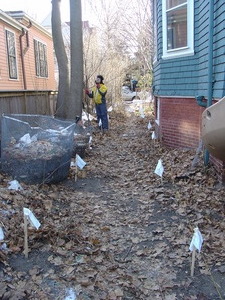
Then it was time for excavating the holes where concrete would eventually be poured. This involved a power auger of
DOOM:
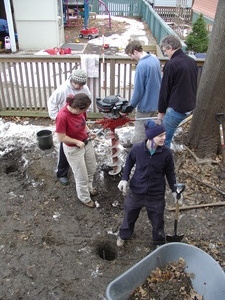
It’s advertised as a 2-man tool. Two 200-pound construction workers, that is. We had to put four people on it plus one person with a shovel clearing dirt to make it manageable, and even then it was a pain. There’s a delicate rhythm you have to get into to avoid getting the bit stuck—DOWN. UP.
CLEAR. And inevitably there are rocks and roots that have to be dealt with.
We lucked out with a fairly warm weekend to do the digging on, but on the first day we still had to deal with a couple inches of frozen ground:

There was also some fun stuff involving having to clear away our (frozen) mulch containers and use a concrete cutter on a weird old concrete pathway that used to run through the same area:

Next we mixed and poured concrete:
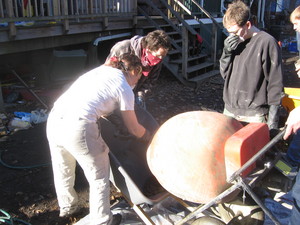
And placed hardware in the concrete to hold the posts:
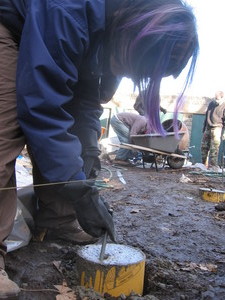
Framing:
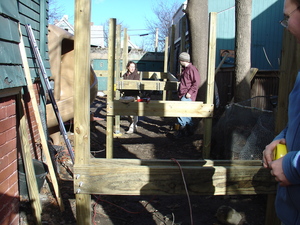
Eventually it became functional, woo:
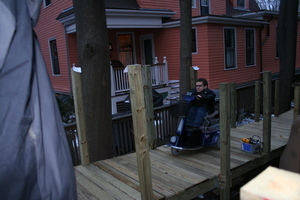
And done! (except for metal handrail):

This all took place over the course of about three weeks. And now our scooter-bound housemate can bring his wheels inside! The house still isn’t totally accessible to wheelchairs/scooters, but at least the first floor is. It really brings me pride to see things like this go from start to finish here. We can do it! This guy who is moving in has really influenced my life—he’s really good at making people feel comfortable talking to him, and for me it’s gone from “wow this is awkward, I have no idea what to say” to “talking to a person with different physical abilities and characteristics seems normal”. And that’s made me a better person.
While investigating planet formation (to
justify support complement a PhD proposal on
ocean planets),
I found this discussion over at
physicsforums
following a
blog entry
by Dr Steinn Sigursson.
(He uses Planet X in his posts but that is too frequently linked with the dwarf planet
Xena Eris, and
besides, Pluto has been demoted, so its Planet 9 we're looking for

).
The question is, how was our solar system created ?
"Looks like the outer solar system, with late heavy bombardment, would have come together nicely if there was another Neptune out there to begin with."
Basically, it appears as though there is a planet or substellar companion star out in the
Oort cloud.
This is
not likely to be the Nemesis object of
Hut's/Muller's theory, but would have been
responsible for the Kuiper belt.
Most of the discussion is about
brown dwarfs,
but following links leads to a paper by
Gomes et al.,
simulating the possibility of outer Neptunes or Jupiters at 4000 AU or 5000 AU.
The thread is all about the dynamics of such bodies, but what would they look like?
-
How bright would they be? Not very. Grabbing some used envelopes and the usual definition, we get
magnitude 27 for
a Jupiter at 5000 AU, or 29 for Neptune at 4000 AU. The limiting magnitude for Hubble is about 30;
finding one would be hard at those brightnesses. This is from reflected (visible)
light from the Sun (solar irradiance at 5000 AU is down to 5 uW / m2 !); perhaps it might radiate a bit more
from internal heat in the infrared.
-
Whats the temperature? At the surface, this depends on how much sunlight it absorbs and how much it reflects: its
albedo.
Using albedos of 0.3 ( typical for an asteroid, "dirty snowball;
see eg. Delbo et al.) ,
0.39 for Earth, or 0.8 for clean ice, we get effective temperatures of 2.5 to 3.5 Kelvin ( -270 ° C)
Now, Hydrogen freezes solid at 14K, Helium is liquid at 4K. So we're talking about a liquid helium ocean on top, with
no atmosphere worth speaking of.
But Could it sustain life?
Not as impossible as it seems.
Ehrenreich and Cassan
point out that an Ice Giant could host a liquid layer underneath an ice shell surface,
heated by radiogenic energy, that could last for billions of years before freezing.
So where would it be? This is the time to submit a grant proposal for more envelopes ...
Tags astronomy, ocean-planets, planet-formation, neptune, ice-giants

 Since I've ranted a little recently lets do
Since I've ranted a little recently lets do  Just read on
Just read on
 OK, after a mainboard replacement by HP, I have my AMD64
OK, after a mainboard replacement by HP, I have my AMD64  I live in a
I live in a 








